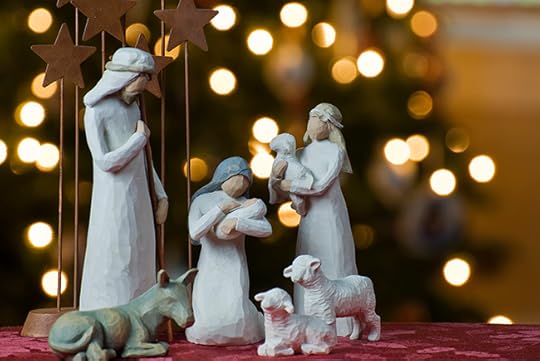Is there a war on Christmas?
Is there a War on Christmas? Of course there is. Donald Trump is sure of it, Bill O’Reilly says so, and John Gibson agrees. The Catholic League for Religious and Civil Rights declares it to be true and the American Family Association does too. It is a calculated and pernicious attack not only on the holiday but on Christianity itself.
Is there a War on Christmas? Of course not. Michelle Goldberg says it is a canard and The New Yorker agrees. Jon Stewart mocks the notion, and The Guardian calls it nonsense. To claim there is such a war is an example of “Christonormativity,” a right-wing plot to bolster the ratings of Fox News and to disguise the drive for Christian theocracy.
Is there a War on Christmas? Yes, indeed. In fact, there is a history of almost two thousand years of opposing, controlling, reforming, criticizing, suppressing, resurrecting, reshaping, appropriating, debating, replacing and abolishing the world’s most popular festival.
Let’s start at the very beginning, in the days of the early Christian Church. It may be surprising to learn that it took several centuries for the faithful to begin to celebrate the nativity of their Saviour. This was a natural response to a belief in the imminent return of Christ—why pay attention to His humble earthly origins when he was soon to return in glory to judge the living and the dead? When Jesus seemed to tarry and Christians were forced to deal with those Gnostics who denied that God had taken on a solid human form, the Church began to emphasize the stories of the Bethlehem birth. There were those Christians, however, who opposed any celebration of the event, saying that birthdays were only for pagans, emperors and pharaohs and the like.
 Nativity scenes, which we’ve grown accustomed to seeing during the holiday season, were seldom found in early Christian celebrations. Image credit: “Nativity” by Jeff Weese. CC BY 2.0 via Flickr.
Nativity scenes, which we’ve grown accustomed to seeing during the holiday season, were seldom found in early Christian celebrations. Image credit: “Nativity” by Jeff Weese. CC BY 2.0 via Flickr.These objections were overcome and by the early 300s the Nativity was being openly marked in the western part of the Roman Empire on December 25. This led to over a century of struggle between those supporting that date and those in the great cities of the east, such as Alexandria and Jerusalem, who would prefer to celebrate both the Nativity and various other sacred moments on January 6. While this argument was being waged, Christian leaders were engaged in another fight, this one against believers who were assimilating the festive practices of pagan Roman holidays like Saturnalia and the Kalends. This argument was going to be waged for centuries and you will still find Christians today who are uneasy about the Christmas tree, gifts, and feasting.
The Protestant Reformation of the sixteenth century dealt a strong blow against Christmas celebrations when it attacked the cult of saints; out went St. Nicholas and other saintly gift-bringers, to be replaced by the figure of the Christ Child and assorted shaggy, monstrous helpers. As the Reformation gained strength, there were calls for Christmas itself to be abolished; the holiday was called popish, pagan, Saturnalian, and debauched. In the 1600s Christmas disappeared from Scotland, England (for a time), parts of the Netherlands and New England colonies, and even when it was restored it had lost the support of the elites—in England and America it had become an alcohol-centered season of low-class rowdiness. During the French Revolution Christmas was derided as part of the worship of that “Jew slave” and dispensed with until the rise of Napoleon.
 The act of gift-giving at Christmas has been criticized as a means of promoting secular traditions over religious celebrations. Image credit: “Christmas presents under the tree” by Alan Cleaver. CC BY 2.0 via Flickr.
The act of gift-giving at Christmas has been criticized as a means of promoting secular traditions over religious celebrations. Image credit: “Christmas presents under the tree” by Alan Cleaver. CC BY 2.0 via Flickr.In the early nineteenth century Christmas was reinvented in England and the United States, becoming more domestic, child-centered and middle-class. Charles Dickens reconnected the holiday with charity and forgiveness while New York poets and artists invented Santa Claus. This was not enough to redeem the celebration in the eyes of fundamental Protestants who fought a rear-guard action to the holiday which continues in the 21st century. The rise of the radical left saw a number of atheist and socialist attempts to replace Christmas with a more secular and socially-progressive December festivity. This was not successful until the 1900s when revolutionary governments in Mexico, China and the Soviet Union succeeded in wiping Christmas off the calendar.
The war around Christmas reached its peak in the 20th century. In Nazi Germany, Hitler’s government realized popular attachment to the holiday was too great for it to be done way with and sought to bend it to their own ends. Christmas became paganized and militarized—St. Nicholas and the Christ Child were replaced by figures from Teutonic folklore while the swastika and solstice sun became suitable ornaments on the Yule tree. After the Second World War, the fight against Christmas was waged on two main fronts—the drive to eliminate it and other religious symbols from public spaces, and the resistance around the world to an Americanized “Coca-Cola” version of the season. Decades of litigation, decrees and legislation has pushed Christmas out of many areas such as schools, hospitals and government property, giving rise to massive resentment against the political correctness that has produced such neologisms as “Sparkle Season,” “The Twelve Days of Giving” and the “Holiday Tree.” In Europe and Latin America, anti-Santa Claus movements have been opposing the American-bred gift-bringer and reviving the claims of the Three Kings, the Christ Child, St. Nicholas and (in a bizarre nationalistic moment in Mexico), the Aztec god Quetzalcoatl.
Christmas plays too large a part in the global economy and the social life of nations and families for it ever to be without controversy. We may expect it to be celebrated and attacked for centuries to come.
Featured image credit: “Santa Christmas ornament” by m01229. CC BY 2.0 via Flickr.
The post Is there a war on Christmas? appeared first on OUPblog.

Oxford University Press's Blog
- Oxford University Press's profile
- 238 followers



